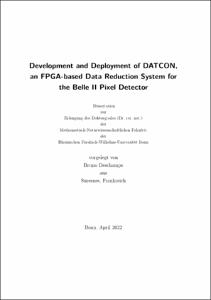Development and Deployment of DATCON, an FPGA-based Data Reduction System for the Belle II Pixel Detector

Development and Deployment of DATCON, an FPGA-based Data Reduction System for the Belle II Pixel Detector

| dc.contributor.advisor | Dingfelder, Jochen Christian | |
| dc.contributor.author | Deschamps, Bruno | |
| dc.date.accessioned | 2022-10-12T07:58:41Z | |
| dc.date.available | 2022-10-12T07:58:41Z | |
| dc.date.issued | 12.10.2022 | |
| dc.identifier.uri | https://hdl.handle.net/20.500.11811/10353 | |
| dc.description.abstract | The SuperKEKB collider located in Tsukuba, Japan, will have a luminosity 40 times higher than its predecessor. With an expected occupancy of 3 %, largely dominated by beam backgrounds, the new pixel DEPFET detector (PXD) produces a theoretical data rate of about 20 GBps. To comply with the Belle II Data Acquisition System, the data rate produced by PXD has to be reduced. By using the hits of the surrounding layers of Silicon-strip Vertex Detectors (SVD), particle trajectories can be reconstructed to create so-called Regions of Interest (ROIs) on the pixel detector. Only the pixels inside a ROI are saved, therefore reducing the amount of PXD data. The DATCON, developed and deployed in the scope of this thesis, contributes to the data reduction. It uses the Hough Transformation technique to extract track parameters and to calculate the intersection of a track with the PXD sensors. The system is built around the μTCA standard and requires two types of Advanced Mezzanine Cards (AMC), each equipped with a Field Programmable Gate Array (FPGA). 52 optical links connect the SVD to the DATCON system and each data stream passes through a pre-processing and multiplexing step before being used for track finding. Two 2D track findings are performed to extract parameters in the r − φ and r − z planes. Their results are merged during ROI creation. The performance of the DATCON algorithm was evaluated with a series of simulations starting at the most simple case of a single track but also with physics data. The most important specifications that characterize DATCON performance are the Data Reduction Factor (DRF) and the ROI Finding Efficiency (RFE). The two are closely related, and parameters of the algorithm can be tuned to optimize them. The ROIs produced based on Belle II data are compared with the ones produced by the High Level Trigger (HLT), bringing the need for extensive analysis. For Υ(4S) events, the overall data reduction factor of 3.5 and a ROI finding efficiency above 85 %, DATCON is not yet sufficient for standalone data reduction. However, it was shown in this thesis, that an FPGA-based, online data reduction works and has potential for further optimization. | en |
| dc.language.iso | eng | |
| dc.rights | In Copyright | |
| dc.rights.uri | http://rightsstatements.org/vocab/InC/1.0/ | |
| dc.subject.ddc | 530 Physik | |
| dc.title | Development and Deployment of DATCON, an FPGA-based Data Reduction System for the Belle II Pixel Detector | |
| dc.type | Dissertation oder Habilitation | |
| dc.publisher.name | Universitäts- und Landesbibliothek Bonn | |
| dc.publisher.location | Bonn | |
| dc.rights.accessRights | openAccess | |
| dc.identifier.urn | https://nbn-resolving.org/urn:nbn:de:hbz:5-68394 | |
| ulbbn.pubtype | Erstveröffentlichung | |
| ulbbnediss.affiliation.name | Rheinische Friedrich-Wilhelms-Universität Bonn | |
| ulbbnediss.affiliation.location | Bonn | |
| ulbbnediss.thesis.level | Dissertation | |
| ulbbnediss.dissID | 6839 | |
| ulbbnediss.date.accepted | 13.04.2022 | |
| ulbbnediss.institute | Mathematisch-Naturwissenschaftliche Fakultät : Fachgruppe Physik/Astronomie / Physikalisches Institut (PI) | |
| ulbbnediss.fakultaet | Mathematisch-Naturwissenschaftliche Fakultät | |
| dc.contributor.coReferee | Bernlochner, Florian | |
| ulbbnediss.contributor.gnd | 1281888990 |
Files in this item
This item appears in the following Collection(s)
-
E-Dissertationen (4118)




